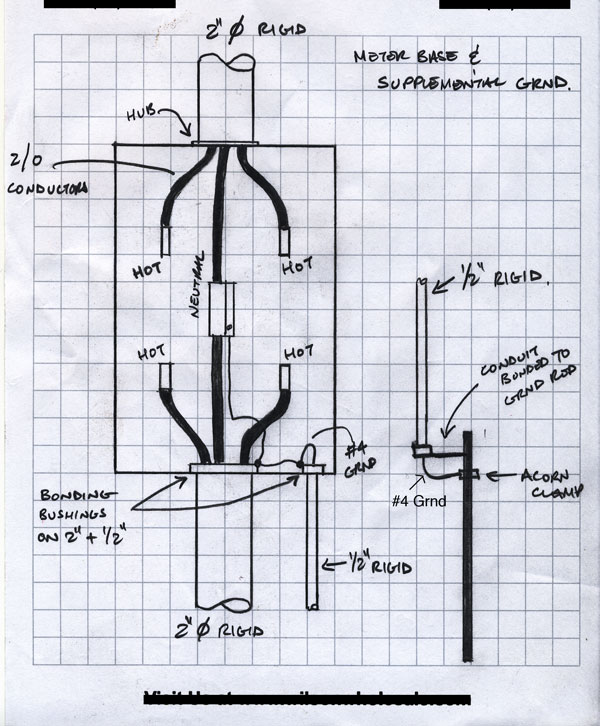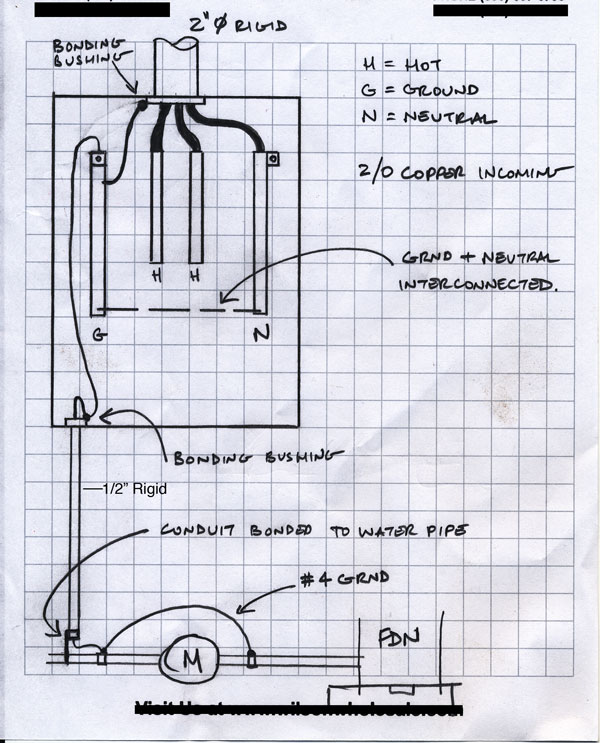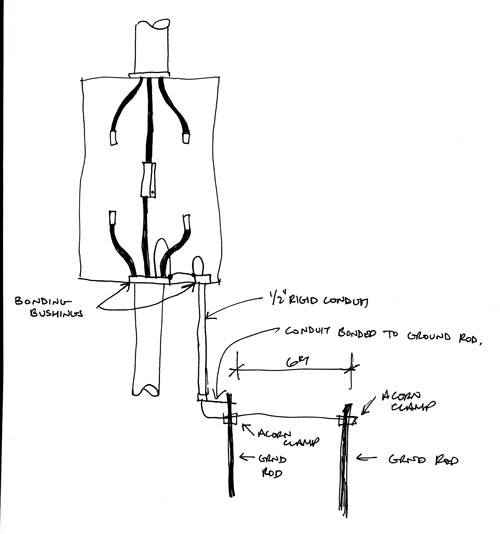You are using an out of date browser. It may not display this or other websites correctly.
You should upgrade or use an alternative browser.
You should upgrade or use an alternative browser.
200A Service Ground/Bond
- Thread starter jawbox
- Start date
- Status
- Not open for further replies.
chris kennedy
Senior Member
- Location
- Miami Fla.
- Occupation
- 60 yr old tool twisting electrician
Use PVC for the GEC, or use a bond bushing on both ends.
Where's the service disconnect? Why are there two locations where the neutral is bonded to the ground? Would the water pipe/meter qualify as a grounding electrode (250.52 A 1), and if it does, does the single rod meet the 25 ohm requirement or where is the second rod? (250.53 D 2) & (250.56) If the main bonding jumper is a screw, the grounding electrodes should terminate at the point where the main bonding screw is installed (250.30 A 3) (The GEC from the rod would terminate at the same point as the GEC from the water pipe).
chris kennedy
Senior Member
- Location
- Miami Fla.
- Occupation
- 60 yr old tool twisting electrician
Don't you need to bond the conduit both ends between the meter can and panel? Using rigid nipple.
PVC is not allowed in my area. Hence rigid to ground rods and water meter.
I can use #6 to the ground rods?
If your using RMC as a raceway for your GEC you need to comply with 250.64(E).
250.64(E) Enclosures for Grounding Electrode Conductors.
Ferrous metal enclosures for grounding electrode conductors shall be electrically continuous from the point of attachment to cabinets or equipment to the grounding electrode and shall be securely fastened to the ground clamp or fitting. Nonferrous metal enclosures shall not be required to be electrically continuous. Ferrous metal enclosures that are not physically continuous from cabinets or equipment to the grounding electrode shall be made electrically continuous by bonding each end of the raceway or enclosure to the grounding electrode conductor. Bonding shall apply at each end and to all intervening ferrous raceways, boxes, and enclosures between the cabinets or equipment and the grounding electrode. The bonding jumper for a grounding electrode conductor raceway or cable armor shall be the same size as, or larger than, the enclosed grounding electrode conductor. Where a raceway is used as protection for a grounding electrode conductor, the installation shall comply with the requirements of the appropriate raceway article.
chris kennedy
Senior Member
- Location
- Miami Fla.
- Occupation
- 60 yr old tool twisting electrician
Sorry.........
Last edited:
- Location
- New Jersey
- Occupation
- Journeyman Electrician (retired)
Your first sketch is fine per the NEC, just bond the GEC to the bottom end of the RMC, the top is bonded with the locknuts.
Roger
Agreed, and get rid of the bonding bushing and jumper on the 2" in the panel enclosure.
don't you need the bushings if the conduit is connected to a concentric knockout?
No, but this is a common misconception.
Roger
- Location
- New Jersey
- Occupation
- Journeyman Electrician (retired)
don't you need the bushings if the conduit is connected to a concentric knockout?
The raceway contains service entrance conductors, therefore it's a service raceway and requires only to be bonded on one end.
- Location
- New Jersey
- Occupation
- Journeyman Electrician (retired)
Still having a hard time getting my head around this.
Would either of these be correct
Option #1
Meter Can
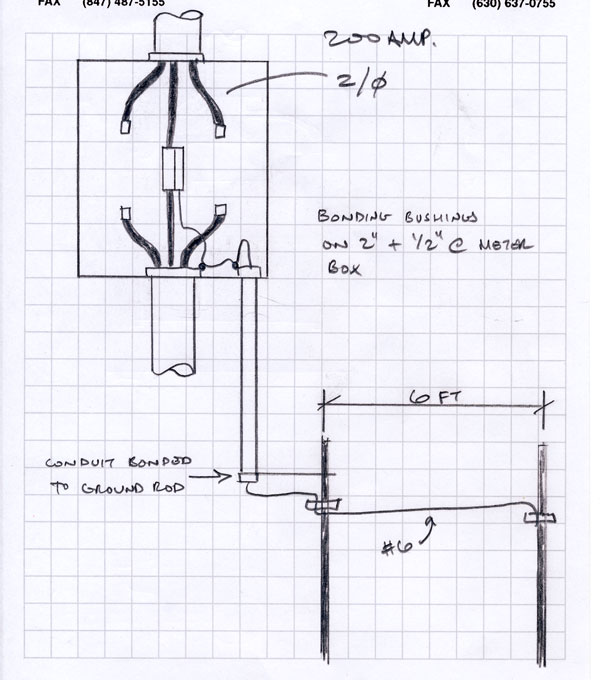
Panel
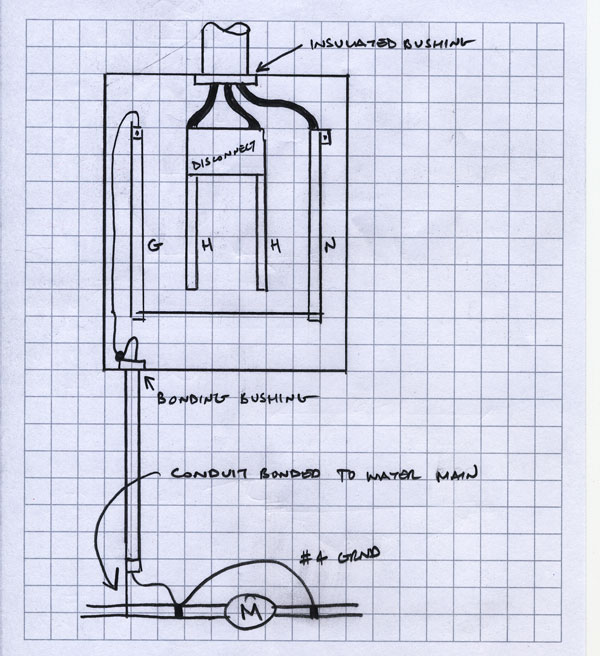
or
Option #2
Meter Can

Panel
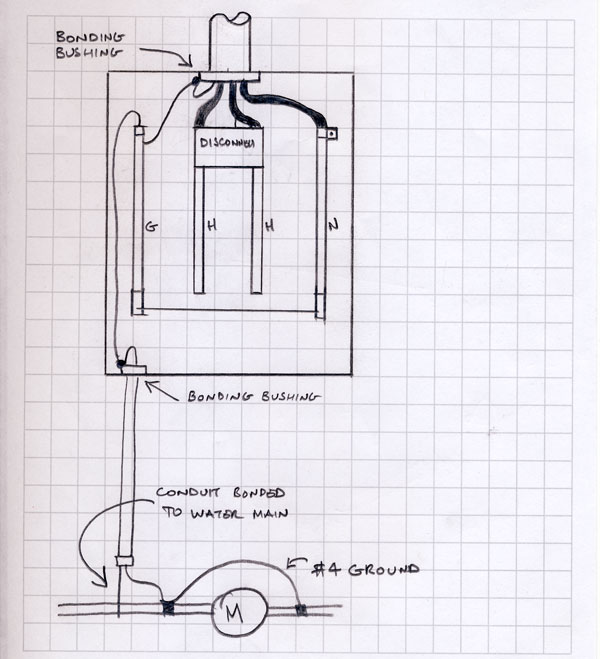
Now you have a problem with the first drawing in option #1. You've changed the #4 to the rod to a #6 and used that to bond the service raceway. The service raceway requires a bonding jumper based on 250.66 which mean that it needs to be a #4.
hurk27
Senior Member
- Location
- Portage, Indiana NEC: 2008
No, but this is a common misconception.
Roger
What about 250.92(A) it is the requirements of Bonding of Services, see (3)
and 250.92(B) is Method of Bonding at the Service see the note under (4)
At a few of the Western sectionals I have been to, this question was brought up more then once and both times the CMP's and UL said the concentric KO's were not listed for grounding of raceways protecting service conductors or GEC's, and cited the above code sections each time.
- Location
- New Jersey
- Occupation
- Journeyman Electrician (retired)
What about 250.92(A) it is the requirements of Bonding of Services, see (3)
and 250.92(B) is Method of Bonding at the Service see the note under (4)
At a few of the Western sectionals I have been to, this question was brought up more then once and both times the CMP's and UL said the concentric KO's were not listed for grounding of raceways protecting service conductors or GEC's, and cited the above code sections each time.
Concentric KO's would mean that you cannot use bonding locknut's to bond service raceways. A bonding jumper would need to be used with a bonding bushing. If you had a KO punched for the size of the raceway then you could use a bonding locknut. 250.92(B)(4).
- Status
- Not open for further replies.

